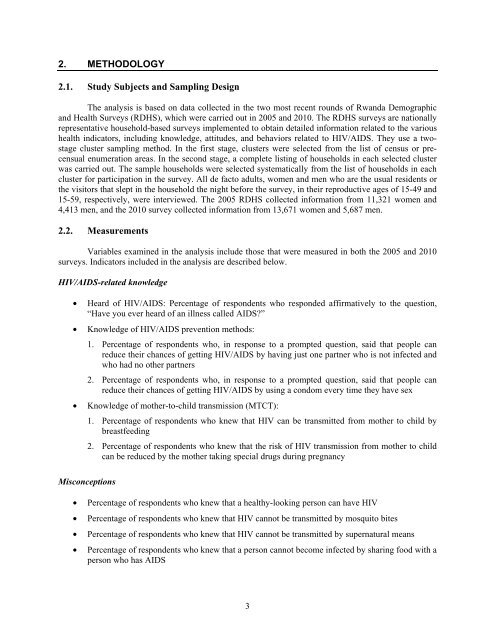Recent Trends in HIV-Related Knowledge and ... - Measure DHS
Recent Trends in HIV-Related Knowledge and ... - Measure DHS
Recent Trends in HIV-Related Knowledge and ... - Measure DHS
Create successful ePaper yourself
Turn your PDF publications into a flip-book with our unique Google optimized e-Paper software.
2. METHODOLOGY2.1. Study Subjects <strong>and</strong> Sampl<strong>in</strong>g DesignThe analysis is based on data collected <strong>in</strong> the two most recent rounds of Rw<strong>and</strong>a Demographic<strong>and</strong> Health Surveys (R<strong>DHS</strong>), which were carried out <strong>in</strong> 2005 <strong>and</strong> 2010. The R<strong>DHS</strong> surveys are nationallyrepresentative household-based surveys implemented to obta<strong>in</strong> detailed <strong>in</strong>formation related to the varioushealth <strong>in</strong>dicators, <strong>in</strong>clud<strong>in</strong>g knowledge, attitudes, <strong>and</strong> behaviors related to <strong>HIV</strong>/AIDS. They use a twostagecluster sampl<strong>in</strong>g method. In the first stage, clusters were selected from the list of census or precensualenumeration areas. In the second stage, a complete list<strong>in</strong>g of households <strong>in</strong> each selected clusterwas carried out. The sample households were selected systematically from the list of households <strong>in</strong> eachcluster for participation <strong>in</strong> the survey. All de facto adults, women <strong>and</strong> men who are the usual residents orthe visitors that slept <strong>in</strong> the household the night before the survey, <strong>in</strong> their reproductive ages of 15-49 <strong>and</strong>15-59, respectively, were <strong>in</strong>terviewed. The 2005 R<strong>DHS</strong> collected <strong>in</strong>formation from 11,321 women <strong>and</strong>4,413 men, <strong>and</strong> the 2010 survey collected <strong>in</strong>formation from 13,671 women <strong>and</strong> 5,687 men.2.2. <strong>Measure</strong>mentsVariables exam<strong>in</strong>ed <strong>in</strong> the analysis <strong>in</strong>clude those that were measured <strong>in</strong> both the 2005 <strong>and</strong> 2010surveys. Indicators <strong>in</strong>cluded <strong>in</strong> the analysis are described below.<strong>HIV</strong>/AIDS-related knowledge• Heard of <strong>HIV</strong>/AIDS: Percentage of respondents who responded affirmatively to the question,“Have you ever heard of an illness called AIDS?”• <strong>Knowledge</strong> of <strong>HIV</strong>/AIDS prevention methods:1. Percentage of respondents who, <strong>in</strong> response to a prompted question, said that people canreduce their chances of gett<strong>in</strong>g <strong>HIV</strong>/AIDS by hav<strong>in</strong>g just one partner who is not <strong>in</strong>fected <strong>and</strong>who had no other partners2. Percentage of respondents who, <strong>in</strong> response to a prompted question, said that people canreduce their chances of gett<strong>in</strong>g <strong>HIV</strong>/AIDS by us<strong>in</strong>g a condom every time they have sex• <strong>Knowledge</strong> of mother-to-child transmission (MTCT):1. Percentage of respondents who knew that <strong>HIV</strong> can be transmitted from mother to child bybreastfeed<strong>in</strong>g2. Percentage of respondents who knew that the risk of <strong>HIV</strong> transmission from mother to childcan be reduced by the mother tak<strong>in</strong>g special drugs dur<strong>in</strong>g pregnancyMisconceptions• Percentage of respondents who knew that a healthy-look<strong>in</strong>g person can have <strong>HIV</strong>• Percentage of respondents who knew that <strong>HIV</strong> cannot be transmitted by mosquito bites• Percentage of respondents who knew that <strong>HIV</strong> cannot be transmitted by supernatural means• Percentage of respondents who knew that a person cannot become <strong>in</strong>fected by shar<strong>in</strong>g food with aperson who has AIDS3







![Obtaining Informed Consent for HIV Testing [QRS4] - Measure DHS](https://img.yumpu.com/49850117/1/190x245/obtaining-informed-consent-for-hiv-testing-qrs4-measure-dhs.jpg?quality=85)








